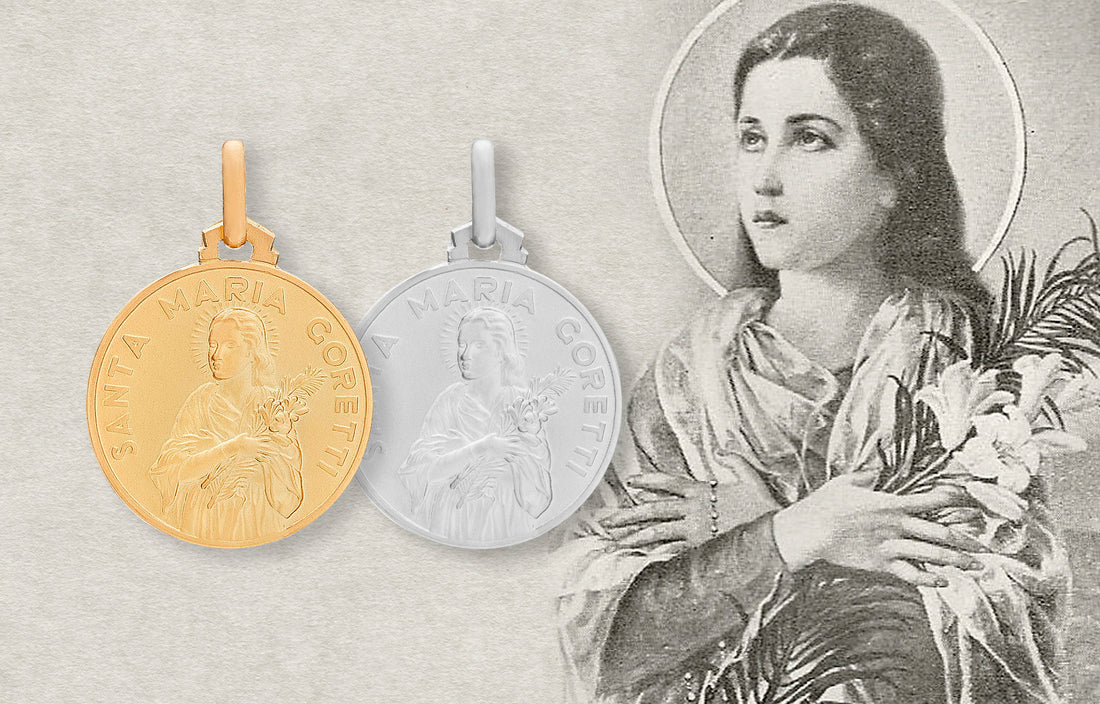Maria Goretti, an illuminating figure of unblemished purity and virtue, has etched an enduring legacy onto the tapestry of faith. The narrative unfolds of a youthful woman, driven by an impassioned commitment to safeguard her purity, ultimately undertaking a heroic deed that not only captivated her assailant but also steered him towards redemption. Though her lifespan was brief, Maria's journey stands as an emblem of fortitude and self-sacrifice, culminating in her beatification in 1947 and canonization in 1950 by Pope Pio XII during the Holy Year.
The Saga of Maria Goretti
In 1890, Maria Goretti took her first breath in Corinaldo, Marche, born into a humble peasant family. Her inception occurred within modest surroundings, yet her profound spiritual connection was palpable from the outset. On the day of her entrance into the world, Maria underwent the sacrament of baptism, adhering to the customs of the time. Her spiritual evolution persisted, culminating at the age of six with the reception of the sacrament of Confirmation. A pivotal juncture in her narrative unfolded when her family opted to relocate to Agro Pontino, Lazio, in pursuit of improved economic prospects. However, this new milieu proved inhospitable, fraught with the specter of maladies like malaria, casting a shadow over everyday existence. The demise of her father due to malaria when Maria was a mere ten years old delivered a devastating blow to the family, already grappling with financial tribulations.
Undeterred by adversities, Maria Goretti exhibited immeasurable faith. Her formative years were tinged with poverty, yet her incandescent spirit and profound faith served as beacons through the darkest hours. Post her father's demise, Maria emerged even more resilient, providing unwavering support to her mother and siblings through love, prayer, and indefatigable toil. As economic circumstances worsened, the Goretti family forged an alliance with the Serenelli family, comprising a father and a son, to confront the rigors of rural existence collectively. While the men toiled in the fields, the women assumed responsibility for meals and childcare. This phase of familial solidarity amidst adversity proved pivotal for young Maria, who continued to manifest extraordinary affection and unyielding commitment.
Resistance and Sacrifice
In the tender embrace of eleven, Maria Goretti voiced a profound longing to partake in the sacrament of Communion. This deep-seated desire impelled her to sacrifice precious hours of sleep, embarking on a journey to attend Sunday Mass in a village situated several kilometers distant from her home. Maria's initial manifestation of faith and unwavering commitment to prayer set her apart even in the dawn of her youth. Maria's tranquility was shattered when she became the target of inappropriate advances from young Serenelli, whom she considered a brother. Maria, however, maintained silence and sought comfort in prayer.
Maria's Valiant Act: A Chronicle of Sacrifice and Redemption
On an ominous day, Maria found herself isolated at home, confronted by an unrelenting assailant bent on violence. In a courageous defense of her purity, Maria resisted the aggressor, enduring grievous wounds. Opting to safeguard her chastity, Maria made the ultimate sacrifice, succumbing to her injuries at the tender age of twelve. Yet, even in her final moments, she extended forgiveness to her assailant. The perpetrator, handed a 30-year prison sentence, underwent a profound transformation during incarceration. Claiming visions of Maria heralding her ascent to heaven, he embarked on a journey of redemption. Post-release, he sought forgiveness from Maria's mother, a gesture underscoring the transformative potential of faith and repentance. Maria Goretti's story is not solely one of sacrifice but also an inspiring testament to hope and forgiveness.
The Path to Beatification and Canonization
Maria attained beatification on April 27, 1947, under the auspices of Pope Pius XII. This formal acknowledgment by the Catholic Church initiated an inspirational saga transcending religious boundaries. Bestowed the title of the patroness of chastity, victims of rape, girls, youth, poverty, and purity, Saint Maria Goretti's life radiated as a beacon beyond the realm of faith. Her beatification, a mere three years after acknowledgment, unfolded on June 24, 1950, during the Holy Year, solidifying her status as a saint. This solemn occasion marked the inception of a venerable tradition, showcasing her purity, courage, and sacrifice as a perennial source of spiritual inspiration for generations.
Sanctuary of Our Lady of Graces in Nettuno
The sacred remains of Maria Goretti find repose in the Sanctuary of Our Lady of Graces in Nettuno, a pilgrimage site that attracts seekers of spiritual solace and connection to the saint's tale of faith and sacrifice. This revered location has evolved beyond a mere pilgrimage site, hosting religious celebrations that draw both local devotees and tourists. Regular solemn masses, processions, and other expressions of devotion create an immersive environment where participants delve into Maria Goretti's narrative of purity and redemption. The conversion journey of Maria's aggressor adds an element of hope and forgiveness, elevating her story into a compelling message of compassion and renewal.
The Medal of Saint Maria Goretti: Emblem of Purity and Devotion
The Medal of Saint Maria Goretti stands as a cherished symbol of purity and devotion, honoring the memory of this young virgin-martyr. As one of the youngest saints canonized, Maria Goretti earned the epithet "Agnes of the 20th Century" from Pope Pius XII. Those who don this medal feel enveloped by the grace of Saint Maria Goretti, invoking her intercession for chastity, purity, and protection against life's adversities.
